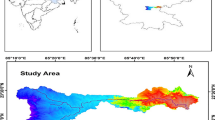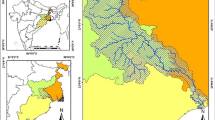Abstract
The objective of this study was to investigate impacts of climate disturbance and watershed management operations on hydrologic functioning of the Kordan watershed in Iran. Soil and water assessment tool was used and evaluated for an 18-year monthly stream discharge. Statistical and graphical analysis of the calibrated and validated model presented appropriate fit to the measured data (NSE and R2 were more than 0.80), allowing reproduction of the historic hydrological conditions of the watershed for future analysis. A 12-month timeframe was achieved from correlation between standardized precipitation index and standardized runoff index to quantify drought characteristics and define drought disturbance scenarios. Replacing normal periods in terms of precipitation amount with extreme and severe periods up to 40% resulted in declining monthly flow out by 24% and 21%, respectively. Pasture restoring scenarios resulted in a significant decline in amount of surface runoff. Replacing 50% of poor rangeland areas with moderate rangeland caused monthly amount runoff to decline by 16%. The percentage of runoff decline raised up to 44% by replacing moderate rangeland thoroughly. Furthermore, land-use scenarios increased amount of subsurface flow considerably. Impacts of constructing hydraulic structures were assessed in each sub-basin separately. Results showed decline in yearly surface runoff varied from 50 to 97%, depending on the volume of structures and sub-basin characteristics. The findings would be beneficial to decision makers which contribute to better understanding of natural and man-made activities on hydro-power potential of watersheds.








Similar content being viewed by others
References
Abbaspour KC (2011) SWAT-CUP4: SWAT calibration and uncertainty programs–a user manual. Swiss Federal Institute of Aquatic Science and Technology, Eawag 106
Anderson JR, Hardy EE, Roach JT, Witmer RE (1976) A land use and land cover classification system for use with remote sensor data. 964
Angela C-B, Javier C-J, Teresa G-M, Marisa M-H (2015) Hydrological evaluation of a Peri-urban stream and its impact on ecosystem services potential. Global Ecol Conserv 3:628–644
Arnold JG, Srinivasan R, Muttiah RS, Williams JR (1998) Large area hydrologic modeling and assessment part I: model develoment 1. J Am Water Resour Assoc 34:73–89
Bobadoye AO, Ogara WO, Ouma GO, Onono JO (2016) Assessing climate change adaptation strategies among rural Maasai pastoralist in Kenya. Am J Rural Dev 4:120–128
Sazeh-Ab-Shafagh Co (2016) Comperehensive—executive studies of aghasht watershed of Savojbolagh, Alborz Province.
Sabz-AndishPayesh Co (2018) Comperehensive: executive studies of Baraghan Watershed of Savojbolagh, Alborz Province
Fan M, Shibata H (2014) Spatial and temporal analysis of hydrological provision ecosystem services for watershed conservation planning of water resources. Water Resour Manage 28:3619–3636
Francesconi W, Srinivasan R, Pérez-Miñana E, Willcock SP, Quintero M (2016) Using the soil and water assessment tool (SWAT) to model ecosystem services: a systematic review. J Hydrol 535:625–636
Gao C, Booij MJ, Xu Y-P (2020) Impacts of climate change on characteristics of daily-scale rainfall events based on nine selected GCMs under four CMIP5 RCP scenarios in Qu River Basin, East China. Int J Climatol 40:887–907
Gathenya M, Mwangi H, Coe R, Sang J (2011) Climate- and land use-induced risks to watershed services in the Nyando River Basin, Kenya. Exp Agric 47:339–356
Ghoraba SM (2015) Hydrological modeling of the Simly Dam watershed (Pakistan) using GIS and SWAT model. Alex Eng J 54:583–594
Gupta HV, Sorooshian S, Yapo PO (1998) Toward improved calibration of hydrologic models: multiple and noncommensurable measures of information. Water Resour Res 34:751–763
Hargreaves GH, Samani ZA (1982) Estimating potential evapotranspiration. J Irrig Drain Div 108:225–230
Herrero M, Thornton PK, Kruska RL, Jones PG, Owiyo T, Kristjanson P, Notenbaert A, Bekele N, Omolo A (2006) Mapping climate vulnerability and poverty in Africa: report to the department for international development
Jain S, Tyagi J, Singh V (2010) Simulation of runoff and sediment yield for a Himalayan watershed using SWAT model. J Water Resour Prot 2010:267–281
Jung I, Bae D-H, Lee BJ (2013) Possible change in Korean streamflow seasonality based on multi-model climate projections. Hydrol Process 27:1033–1045
Karlsson IB et al (2016) Combined effects of climate models, hydrological model structures and land use scenarios on hydrological impacts of climate change. J Hydrol 535:301–317
Kim D-H, Jang T, Hwang S (2020) Evaluating impacts of climate change on hydrology and total nitrogen loads using coupled APEX-paddy and SWAT models. Paddy Water Environ, 18:515–529
Li E, Mu X, Zhao G, Gao P, Sun W (2016) Effects of check dams on runoff and sediment load in a semi-arid river basin of the Yellow River. Stoch Environ Res Risk Assess 31:1791–1803
Lin F, Chen X, Yao H, Lin F (2022) SWAT model-based quantification of the impact of land-use change on forest-regulated water flow. CATENA 211:105975
McKee TB, Doesken NJ, Kleist JR (1993) The relationship of drought frequency and duration to time scales
Moriasi ND, Arnold JG, Van Liew, MW, Bingner RL, Harmel RD, Veith TL (2007) Model evaluation guidelines for systematic quantification of accuracy in watershed simulations. Trans ASABE 50:885–900
Mukheibir P (2007) The impact of climate change on small municipal water resource management. The case of Bredasdorp, South Africa.
Nash JE, Sutcliffe JV (1970) River flow forecasting through conceptual models part I: a discussion of principles. J Hydrol 10:282–290
Ndulue EL, Ezenne GI, Mbajiorgu CC, Ogwo V, OgbuK N (2018) Hydrological modelling of upper Ebonyi watershed using the SWAT model. Int J Hydrol Sci Technol 8:120–133
Norman LM, Niraula R (2016) Model analysis of check dam impacts on long-term sediment and water budgets in Southeast Arizona, USA. Ecohydrol Hydrobiol 16:125–137
Osei MA, Amekudzi LK, Wemegah DD, Preko K, Gyawu ES, Obiri-Danso K (2019) The impact of climate and land-use changes on the hydrological processes of Owabi catchment from SWAT analysis. J Hydrol Reg Stud 25:100620
Piman T, Cochrane TA, Arias ME, Green A, Dat ND (2013) Assessment of flow changes from hydropower development and operations in Sekong, Sesan, and Srepok Rivers of the Mekong Basin. J Water Resour Plan Manag 139:723–732
Porhemmat J, Altafi Dadgar M (2023) Analysis of hydrological drought indices in Alpine Zagros Mountains of Iran. Arab J Geosci 16:594
Qasim M, Hubacek K, Termansen M (2013) Underlying and proximate driving causes of land use change in district Swat, Pakistan. Land Use Policy 34:146–157
Rodrigues DBB, Gupta HV, Mendiondo EM (2014) A blue/green water-based accounting framework for assessment of water security. Water Resour Res 50:7187–7205
Salmoral G, Willaarts BA, Troch PA, Garrido A (2015) Drivers influencing streamflow changes in the Upper Turia basin, Spain. Sci Total Environ 503–504:258–268
Sarmadian F, Rahimy P, Keshavarzi A (2010) Modeling of sediment yield and bicarbonate concentration in Kordan Watershed. J Agric Sci Technol 12:121–131
Shi P, Zhang Y, Ren Z, Yu Y, Li P, Gong J (2019) Land-use changes and check dams reducing runoff and sediment yield on the Loess Plateau of China. Sci Total Environ 664:984–994
Shukla S, Wood AW (2008) Use of a standardized runoff index for characterizing hydrologic drought. Geophys Res Lett 35
Tamm O, Maasikamäe S, Padari A, Tamm T (2018) Modelling the effects of land use and climate change on the water resources in the eastern Baltic Sea region using the SWAT model. CATENA 167:78–89
Wang Q, Liu R, Men C, Guo L, Miao Y (2018) Effects of dynamic land use inputs on improvement of SWAT model performance and uncertainty analysis of outputs. J Hydrol 563:874–886
Wu D, Cui Y, Xie X, Luo Y (2019) Improvement and testing of SWAT for multi-source irrigation systems with paddy rice. J Hydrol 568:1031–1041
Acknowledgements
This research was supported by a research fund of Soil Conservation and Watershed Management Research Institute (SCWMRI) of Iran. The authors are grateful for their logistic and funding supports. In addition, we would like to thank Dr. Jahangir Porhemmat for numerous interesting discussions on this topic.
Author information
Authors and Affiliations
Corresponding author
Ethics declarations
Declarations
The authors declare that there is no any conflict of interest in the subject matter or materials discussed in this manuscript.
Rights and permissions
Springer Nature or its licensor (e.g. a society or other partner) holds exclusive rights to this article under a publishing agreement with the author(s) or other rightsholder(s); author self-archiving of the accepted manuscript version of this article is solely governed by the terms of such publishing agreement and applicable law.
About this article
Cite this article
Altafi Dadgar, M., Mohammadzadeh, H. Modeling the impacts of natural and anthropogenic processes on the hydrologic components in Kordan watershed, Iran. Paddy Water Environ 22, 301–311 (2024). https://doi.org/10.1007/s10333-024-00968-8
Received:
Revised:
Accepted:
Published:
Issue Date:
DOI: https://doi.org/10.1007/s10333-024-00968-8




